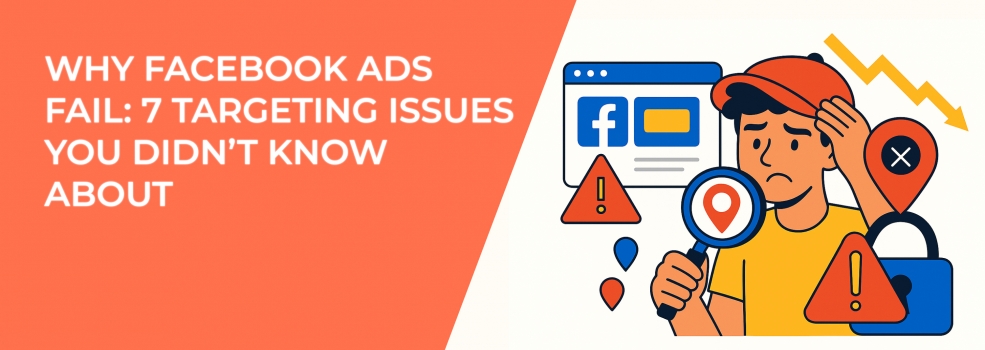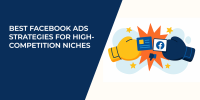You’ve crafted a compelling offer, polished the creative, launched your Facebook or Instagram campaign, and then… nothing. Maybe you get clicks, but conversions are nowhere in sight.
So what’s going wrong?
For many advertisers, the issue isn’t the ad itself. It’s the targeting. If your message reaches the wrong people or the right people at the wrong time, even the best creative won’t perform.
In this guide, we’ll explore seven subtle but high-impact targeting mistakes that could be quietly draining your ad budget. More importantly, we’ll show you how to correct them so your campaigns start delivering real results.
Mistake #1. You’re relying on Facebook’s automation too early
Facebook’s automation tools — like Advantage+ campaigns, dynamic creatives, and automatic placements — are built to help advertisers scale. But automation can only work after the algorithm has learned what your ideal customer looks like. If you use these tools too early, especially in new accounts or campaigns without conversion data, you may end up attracting the wrong audience and burning your budget.
In early phases, Facebook’s algorithm often goes after the lowest-hanging fruit — clicks or views — instead of the users most likely to convert. Without a strong data foundation, automation becomes guesswork.
How to fix it: start with manual, data-driven targeting to guide the algorithm.
-
Build intent-based seed audiences. Use Custom Audiences like recent buyers, high-intent website visitors, or people who engaged with lead forms.
-
Use manual placements and segmentation. Don’t let Facebook default to broad targeting or automatic placements until you have proof they convert.
-
Monitor quality over quantity. Track post-click metrics like bounce rate, time on site, and scroll depth to assess traffic quality, not just cost-per-click.
Once you have a history of qualified leads or purchases, gradually introduce automation to scale. Learn how to finish the Facebook learning phase quickly to give automation the data it needs to perform.
Mistake #2. You’re using lookalikes built on weak source audiences
Lookalike Audiences can be one of the most powerful tools in your Facebook ad strategy, but only if your seed audience is strong. Many advertisers make the mistake of creating Lookalikes based on page likes, video views, or cold email lists. The result? Facebook finds people who look similar to low-value users, leading to poor performance.
Even worse, if your original audience includes users who only signed up for a freebie, your Lookalike will likely mirror that behavior, resulting in window shoppers, not buyers.
A better approach: make sure your Lookalike source reflects your best customers.
-
Use high-intent behaviors. Build your Lookalikes from recent purchasers, completed lead forms, or loyal customers with high lifetime value.
-
Start small and scale. Use a 1% Lookalike to maintain precision. Once you see results, expand gradually to 2-5%.
-
Refine and refresh. Don’t let your source audience go stale. Update it regularly with new data, and remove churned or inactive users.
Need help choosing the right audience types? Read Custom vs Lookalike Audiences: What Works Best for Facebook Campaigns for a breakdown of when and how to use each.
Mistake #3. You’re taking interest targeting at face value
Interest targeting is often one of the first strategies advertisers use and one of the most misunderstood. Facebook builds interest audiences based on behavior, page interactions, and third-party data. But these interests are often outdated or loosely defined.
Someone listed as “interested in entrepreneurship” may have lliked a single startup meme three years ago. That doesn’t mean they’re actively shopping for business software today.
How to use interests more effectively: go beyond surface-level targeting.
-
Test interest stacking. Combine multiple related interests to narrow down to highly specific subgroups (e.g., “Email Marketing” + “ClickFunnels” + “Digital Strategy”).
-
Warm up cold interest audiences. Use interest targeting at the top of the funnel, then create Custom Audiences from clicks or video views for retargeting.
-
Split-test granular interest groups. Break out audiences into separate ad sets to find which ones actually convert — don’t lump everything together.
Dive deeper into segmentation strategies with Interest Stacking: A Powerful Method for Facebook Audience Segmentation.
Mistake #4. You’re choosing the wrong campaign objective
Facebook optimizes your campaign based on the objective you select. So if you choose "Traffic", Facebook will go out and find people who are likely to click even if they’re unlikely to buy. Choosing the wrong objective is one of the most common — and most costly — Facebook ad mistakes.
Match your objective to your business goal: your objective tells Facebook what success looks like.
-
Use Sales, not Traffic, when your goal is sales or leads — but only if you have enough event data (usually at least 50 conversions/week).
-
Choose Engagement for low-cost top-of-funnel reach, but follow up with retargeting.
-
Set up event tracking properly. Make sure your Pixel and Conversion API are tracking key actions accurately so Facebook can optimize the right behaviors.
Not sure where to start? This guide on Meta Ad Campaign Objectives explains which objectives to use for every stage of the funnel.
Mistake #5. You’re treating all warm audiences the same
Not all warm leads are created equal. Someone who glanced at your homepage isn’t as far along the buyer’s journey as someone who initiated checkout. Treating them the same in your retargeting campaigns can lead to wasted spend and missed conversions.
Segment warm traffic more effectively: divide audiences by intent level and tailor your messaging.
-
Low intent (e.g., home page views, 3-second video watchers) → Use educational content, lead magnets, or social proof to nurture them further.
-
Mid intent (e.g., product page views, 75% video views, email signups) → Offer value-based content, benefit-driven ads, or feature highlights to deepen consideration.
-
High intent (e.g., cart abandoners, checkout initiators) → Use urgency, scarcity, testimonials, or time-limited offers to drive action.
Bonus tip: recency matters. Someone who visited your pricing page yesterday is more valuable than someone who did it six weeks ago. Use Custom Audience time windows (e.g., 3-day vs. 30-day) to prioritize your hottest traffic.
Mistake #6. You’re getting clicks, but from the wrong places
High click volume doesn’t always mean high performance. If you’re getting lots of traffic but no conversions, your placements might be the culprit. The Audience Network and Instant Articles, for example, often generate low-quality or accidental clicks, especially from mobile games and low-engagement sites.
Clean up your traffic: identify and prioritize high-converting placements.
-
In Ads Manager, break down performance by placement.
-
Look for placements with high clicks but low conversion rates.
-
Exclude underperforming placements like Audience Network or Instant Articles.
-
Focus your budget on high-intent areas like:
-
Facebook Feed,
-
Instagram Feed,
-
Stories,
-
Reels.
-
Also, make sure your campaign objective is optimized for conversions, not just link clicks. Link click campaigns attract curiosity; conversion-optimized campaigns attract buyers.
Mistake #7. You’re forgetting to exclude the right people
One of the most overlooked tactics in Facebook ad targeting is exclusions. If you don’t exclude people who’ve already converted (or who shouldn’t see the ad at all), you’re wasting money and creating a bad user experience.
Think about it: someone just bought your product and sees an ad for the same thing with a discount the next day. Ouch.
Use exclusions to build into every campaign:
-
Past purchasers using Pixel events, thank-you pages, or CRM lists.
-
Lead form submitters or converters who already downloaded your offer.
-
Internal users like employees, agencies, or test accounts.
-
Repeat buyers (if your product has a long purchase cycle) — apply a 30- or 60-day cooldown.
Pro tip: use dynamic exclusion lists that update based on real-time behavior. This helps you run more personalized, efficient campaigns and ensures users only see ads relevant to their current stage in the funnel.
Recap: Better targeting = better ROI
Your Facebook ads don’t need more budget — they need better targeting. From how you segment warm traffic to the seed audiences you build your Lookalikes on, every targeting decision either improves your efficiency or drains your spend.
The goal isn’t to reach more people — it’s to reach the right people with the right message at the right time.
Audit your campaigns with these seven principles in mind. Fix one at a time, test methodically, and watch your costs drop while conversions rise.

